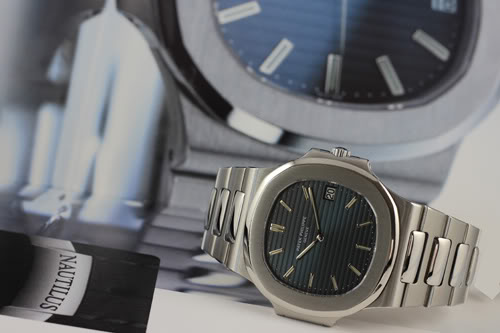The origins of the Patek Philippe Nautilus
Taken from the third volume of Collecting Nautilus and Patek Philippe
The 1970’s was an extremely difficult period for the Swiss watchmaking industry in general; we remember how, during that decade, the cutthroat competition of the €made in Japan€ quartz watches forced the Swiss entrepreneurs to carefully review their organizations and to put their products through a major lifting surgery.
Patek Philippe management had foreseen the need for change, it was necessary to refresh the €cliche€ of the brand, by extending the range of products to more modern models. Perpetuate the tradition whilst simultaneously rejuvenating the effigy which the public itself had created about the brand. For Patek Philippe, this had become a priority strategy; new designs were therefore sought for, such as the Ellipse, which was recently launched and the Nautilus, which fitted perfectly with this strategy of dynamic product renewal, with its innovative shape and the choice of steel as its metal.
The Nautilus is in fact the symbol of this evolution: a steel sports-elegant watch for dynamic men, the managers of the new generation.
This model was designed in 1972 by Geral Genta and it was born from a sketch on a napkin in a Basel restaurant.
The name itself was an excellent choice, the symbolic reference to the Undersea Adventures of Captain Nemo based on the novel by Jules Verne €Twenty Thousand Leagues Under the Sea€.
It was called Nautilus because the shape of its case recalled the porthole of old transatlantic liners and it clearly stated the ambitions and expectations of reliability that engineers from Patek Philippe had foreseen for this watch, even in extreme conditions.
It is interesting to note that, just as the Nautilus, another model designed by Gerald Genta in 1968 with an innovative and distinctive shape, the Royal Oak from Audemars Piguet, had the same difficulty in establishing itself at the outset.
The public reaction to its aesthetics rapidly demonstrated that it was a model which was too modern with respect to the elegant sportsman concept highly considered at that time. Due to its large dimensions, very unusual in the 70’s (42mm diameter and a thickness of 7.60mm), when most models in manufacture varied from 33 to 37mm in diameter, it clearly shocked and did not enthuse the public: the time was not yet ripe.
It wouldn’t be a happy ending story if these two models hadn’t been understood and appreciated as time went by. Finally, the creative genius won and today these two references are €vedettes€, the favourite piece of two prestigious brands.
Read the complete story in the three volumes set Collecting Nautilus and Patek Philippe
